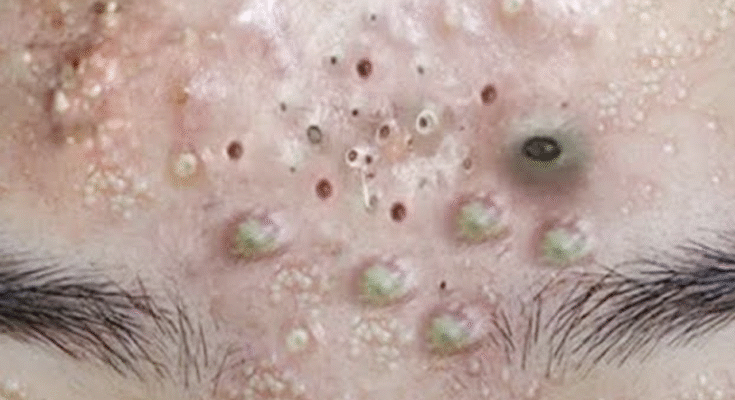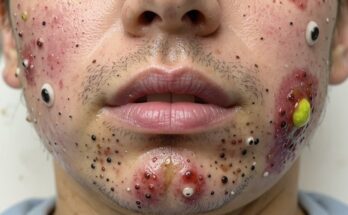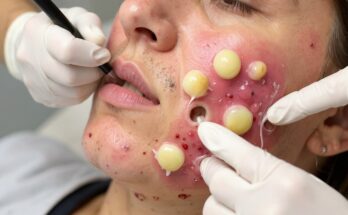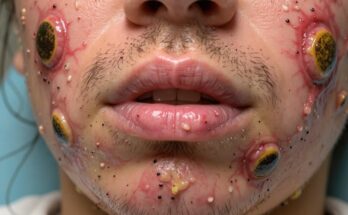Acne may come and go, but the marks it leaves behind can linger for months—or even years. For many, the battle doesn’t end when breakouts stop. Instead, they’re left with stubborn acne scars and hyperpigmentation that seem impossible to fade.
If you’ve ever stared in the mirror and felt frustrated by dark spots or uneven texture, you’re not alone. Nearly 80% of people who experience acne develop some degree of post-acne marks. The good news? You can fade them—with the right understanding, ingredients, and treatments.
This guide will walk you through everything you need to know about the different types of acne scars and hyperpigmentation, how they form, and the most effective, science-backed ways to treat and prevent them.
By the end, you’ll have a complete roadmap to smoother, more radiant, and even-toned skin.
1. Understanding the Difference Between Acne Scars and Hyperpigmentation
One of the biggest skincare misconceptions is that all marks left after acne are scars. In reality, not all discoloration is true scarring.
Let’s clarify the difference first—because the treatments for each are completely different.
| Type | Cause | Appearance | Treatment Focus |
|---|---|---|---|
| Acne Scars | Damage to skin structure from inflammation | Textural irregularities (pits, depressions, raised bumps) | Collagen stimulation (microneedling, laser, retinoids) |
| Post-Inflammatory Hyperpigmentation (PIH) | Excess melanin after inflammation | Flat brown, red, or dark marks | Pigment reduction (brightening agents, exfoliation, sun protection) |
In short:
-
Scars affect texture.
-
Hyperpigmentation affects color.
And while both can appear after acne, their causes and solutions differ significantly.
2. The Science of Acne Scars
2.1 How Acne Scars Form
When a pimple penetrates deeply into the skin, it damages the tissues underneath. Your body naturally tries to repair the damage by producing collagen — a structural protein that gives your skin strength and elasticity.
But the process isn’t always perfect:
-
Too little collagen → depressed (atrophic) scars
-
Too much collagen → raised (hypertrophic or keloid) scars
2.2 Types of Acne Scars
1. Ice Pick Scars
-
Deep, narrow, and sharply defined.
-
Look like small puncture holes.
-
Usually resistant to topical treatments; best treated with professional procedures like TCA CROSS or microneedling.
2. Boxcar Scars
-
Round or oval depressions with well-defined edges.
-
Common on the cheeks and temples.
-
Result from collagen loss.
3. Rolling Scars
-
Wave-like indentations caused by fibrous bands pulling the skin downward.
-
Respond well to subcision and microneedling.
4. Hypertrophic and Keloid Scars
-
Raised and thickened scars caused by excess collagen.
-
More common on the chest, shoulders, and jawline.
-
Require different approaches, such as steroid injections or laser therapy.
3. The Science of Hyperpigmentation
3.1 What Causes Post-Inflammatory Hyperpigmentation (PIH)?
After inflammation (like a breakout or skin trauma), melanocytes — the cells that produce melanin — become overactive. They release extra pigment as the skin heals, leaving behind dark spots or patches.
PIH is not a true scar, but it can last months or even years if untreated.
3.2 PIE vs. PIH
You might also hear about Post-Inflammatory Erythema (PIE) — which looks similar but has a different cause.
| Condition | Color | Cause | Treatment Focus |
|---|---|---|---|
| PIH | Brown or dark spots | Excess melanin | Brightening ingredients (Vitamin C, azelaic acid) |
| PIE | Pink, red, or purplish marks | Damaged blood vessels | Vascular treatments (niacinamide, laser therapy) |
4. Step-by-Step Plan to Fade Acne Scars and Hyperpigmentation
Achieving clear, even skin is a gradual process — it can take several months of consistent care. Here’s the most effective, dermatologist-approved roadmap to fading scars and dark spots.
Step 1: Stop New Breakouts First
You can’t heal scars while new acne is forming. Continuous breakouts restart the inflammation process, worsening scars and pigmentation.
Your goal: Control active acne first.
How:
-
Use salicylic acid (BHA) cleansers to unclog pores.
-
Apply benzoyl peroxide to kill acne-causing bacteria.
-
Introduce a retinoid (tretinoin, adapalene) for cell turnover and prevention.
-
Avoid picking or squeezing pimples — this causes deeper injury and scarring.
Step 2: Exfoliate Consistently (But Gently)
Exfoliation removes dead skin cells and promotes new, evenly pigmented cells to surface faster.
Chemical Exfoliants:
-
AHAs (Alpha Hydroxy Acids): Glycolic and lactic acids resurface the skin.
-
BHAs (Beta Hydroxy Acids): Salicylic acid unclogs pores and reduces inflammation.
-
PHAs (Polyhydroxy Acids): Gentle exfoliants for sensitive skin.
Start 2–3 times per week, then adjust based on tolerance.
Pro Tip: Over-exfoliation causes redness and worsens pigmentation. Balance with hydration and barrier repair products.
Step 3: Brighten and Fade Pigmentation
Here are the most effective, research-backed ingredients for fading dark marks and discoloration:
| Ingredient | How It Works | Best Used As |
|---|---|---|
| Vitamin C | Inhibits melanin production; antioxidant protection | Morning serum |
| Niacinamide | Reduces melanin transfer; strengthens barrier | Serum (AM/PM) |
| Azelaic Acid | Brightens skin and targets acne bacteria | Cream or gel (AM/PM) |
| Alpha Arbutin | Natural skin-lightener; gentle and effective | Serum (AM/PM) |
| Tranexamic Acid | Fades stubborn pigmentation by blocking melanin pathways | Serum or booster |
| Licorice Root Extract | Soothes and reduces dark spots | Add-on ingredient in brightening serums |
Pro Tip: Combine ingredients strategically.
Example: Vitamin C (AM) + Niacinamide (PM) or Azelaic Acid + Niacinamide (both AM/PM) for powerful yet gentle results.
Step 4: Rebuild Collagen to Smooth Texture
If your scars are indented or uneven, you need to stimulate collagen production to rebuild your skin’s structure.
a. Topical Retinoids
-
Boost collagen and cell turnover.
-
Improve both acne scars and pigmentation.
-
Use at night, starting 2–3 times per week.
b. Microneedling
-
Tiny needles trigger controlled injury to stimulate new collagen.
-
Best for rolling and boxcar scars.
-
3–6 sessions are usually recommended.
c. Laser Treatments
-
Fractional CO₂ Laser: Deep resurfacing for severe scars.
-
Er:YAG Laser: Gentler resurfacing with faster healing.
-
Pulsed Dye Laser (PDL): Targets redness and PIE.
d. Chemical Peels
-
Medium-depth peels (like TCA or Jessner’s) help with pigmentation and texture.
-
Stimulate collagen renewal and exfoliate old cells.
e. PRP (Platelet-Rich Plasma)
-
Uses your own growth factors to boost collagen synthesis.
-
Often combined with microneedling for enhanced results.
Step 5: Hydrate and Repair Your Skin Barrier
The skin barrier protects against inflammation and pigment triggers. A compromised barrier can slow healing and worsen discoloration.
Look for moisturizers containing:
-
Ceramides — rebuild the skin’s lipid barrier.
-
Hyaluronic Acid — hydrates and plumps.
-
Panthenol (B5) — soothes irritation.
-
Centella Asiatica (Cica) — calms inflammation and supports repair.
Pro Tip: Apply moisturizer after active serums to lock in hydration and minimize irritation.
Step 6: Protect Against UV Damage Every Single Day
This step is non-negotiable.
Sun exposure darkens pigmentation and delays healing, even on cloudy days.
Your SPF checklist:
-
Broad-spectrum protection (UVA + UVB)
-
SPF 30 or higher
-
Oil-free and non-comedogenic
-
Reapply every 2–3 hours if outdoors
Bonus: Choose tinted sunscreens with iron oxides — they protect against visible light, which worsens pigmentation in darker skin tones.
Without daily sunscreen, even the best treatments won’t deliver lasting results.
5. Professional Treatments for Faster Results
For deeper scars or stubborn dark spots, dermatologist treatments can offer significant improvement.
5.1 Chemical Peels
-
Use acids (like glycolic, salicylic, or TCA) to exfoliate and renew skin layers.
-
Help fade PIH and stimulate collagen.
-
Require professional application for safety.
5.2 Laser Resurfacing
-
Fractional lasers break down scar tissue and promote new collagen.
-
Ideal for atrophic scars.
-
Multiple sessions needed for best results.
5.3 Microneedling with PRP
-
Combines collagen induction with natural growth factors.
-
Reduces texture irregularities and brightens tone.
5.4 Subcision
-
Minor in-office procedure that releases fibrous bands under rolling scars.
-
Usually combined with fillers or microneedling.
5.5 Fillers
-
Temporarily fill depressed scars with hyaluronic acid.
-
Smooths skin immediately while long-term collagen builds.
5.6 Cryotherapy (for Raised Scars)
-
Freezes keloids or hypertrophic scars to flatten them.
-
Often used with steroid injections.
6. Natural and At-Home Remedies (That Actually Work)
While DIY skincare can’t replace medical treatments, some natural ingredients have proven brightening and anti-inflammatory properties.
6.1 Aloe Vera
-
Soothes irritation and supports wound healing.
-
Can slightly fade mild pigmentation.
6.2 Green Tea Extract
-
Rich in antioxidants that reduce redness and oxidative stress.
6.3 Licorice Root
-
Contains glabridin — a natural tyrosinase inhibitor that lightens dark spots.
6.4 Turmeric
-
Contains curcumin, which reduces inflammation and pigment overproduction.
-
Use only in formulated skincare to avoid staining and irritation.
Avoid:
-
Lemon juice, baking soda, or undiluted essential oils — these can burn or irritate the skin and worsen discoloration.
7. The Role of Diet and Lifestyle in Skin Recovery
Healing happens faster when your internal health supports your skin.
7.1 Nutrients for Skin Repair
-
Vitamin C: Collagen synthesis and antioxidant protection.
-
Vitamin E: Reduces inflammation and supports healing.
-
Zinc: Regulates oil and inflammation.
-
Omega-3s: Anti-inflammatory support for hormonal balance.
7.2 Lifestyle Tips
-
Sleep 7–9 hours — collagen regenerates during deep sleep.
-
Stay hydrated — boosts skin elasticity.
-
Avoid smoking — it restricts blood flow to the skin.
-
Manage stress — cortisol spikes worsen inflammation and slow healing.
8. How Long Does It Take to See Results?
Patience is essential. Healing depends on the severity of scars, skin type, and treatment consistency.
| Treatment Type | Visible Results In |
|---|---|
| Topical brightening products | 6–12 weeks |
| Retinoids | 3–6 months |
| Chemical peels | 1–3 sessions |
| Microneedling or PRP | 3–6 sessions |
| Laser treatments | 1–5 sessions |
Skin renewal is gradual — progress can be subtle at first but compounds over time.
9. Preventing Future Scars and Dark Marks
To Avoid New PIH or Scars:
-
Don’t pick, pop, or squeeze pimples.
-
Treat acne early to prevent inflammation.
-
Always wear sunscreen.
-
Maintain consistent skincare habits.
-
Balance your hormones and diet.
Post-Acne Healing Routine:
-
Gentle cleanse
-
Brightening serum (Vitamin C or niacinamide)
-
Barrier-repair moisturizer
-
SPF 30–50 daily
Consistency and prevention go hand in hand.
10. Emotional Impact and Self-Confidence
Post-acne marks aren’t just skin deep. They can affect your confidence and mental health.
Remember:
-
Scars don’t define your worth.
-
Every step toward healing matters.
-
You’re not alone — millions share your journey.
-
With time and care, your skin will heal.
Confidence grows not from perfect skin, but from understanding your body and taking consistent, compassionate care of it.
11. Key Takeaways
| Concern | What It Is | Best Treatments |
|---|---|---|
| PIH (Brown spots) | Overproduction of melanin | Vitamin C, Niacinamide, Azelaic Acid, Sunscreen |
| PIE (Red marks) | Blood vessel dilation | Niacinamide, Laser (PDL), Centella Asiatica |
| Atrophic Scars | Collagen loss | Retinoids, Microneedling, PRP, Laser |
| Hypertrophic Scars | Collagen overgrowth | Steroid injections, Silicone gels, Cryotherapy |
12. The Bottom Line: Clear, Even Skin Is Possible
Fading acne scars and hyperpigmentation takes patience, consistency, and a strategy rooted in science.
There’s no single “miracle product,” but the right combination of brightening agents, collagen stimulators, and diligent sun protection can transform your skin over time.
Every exfoliation, serum, and sunscreen application is a step closer to balance.
Be patient. Be consistent. And most importantly — be kind to your skin.
Because healing isn’t just about clearer skin — it’s about reclaiming confidence, one cell at a time.



